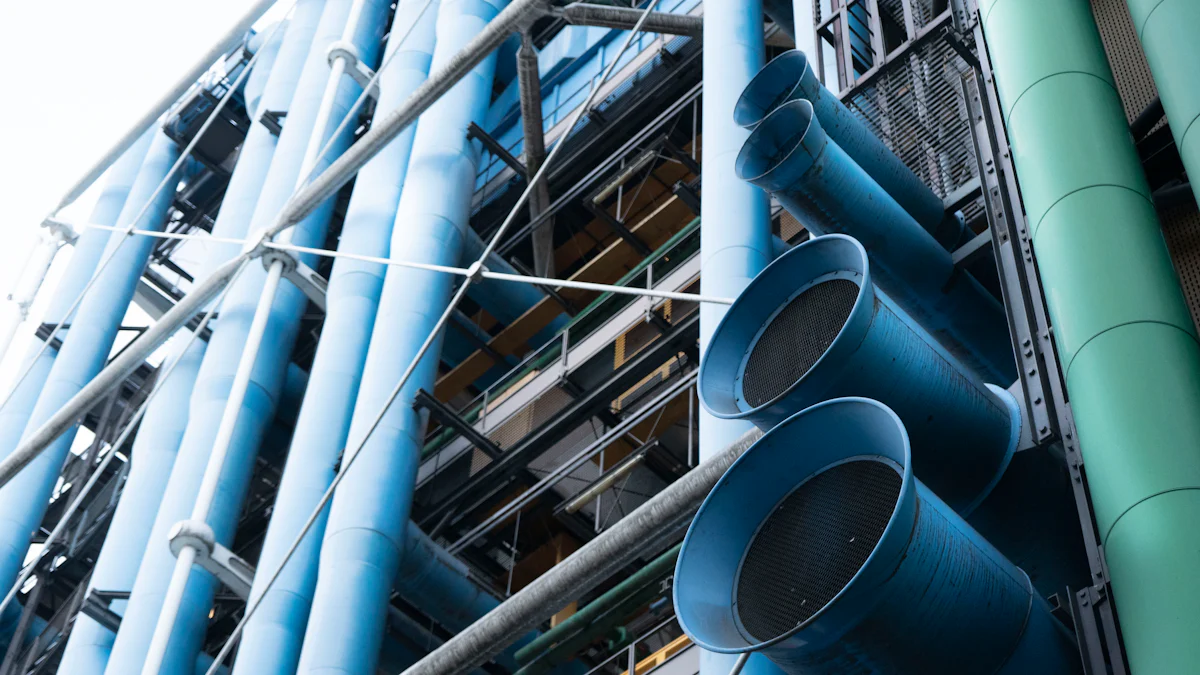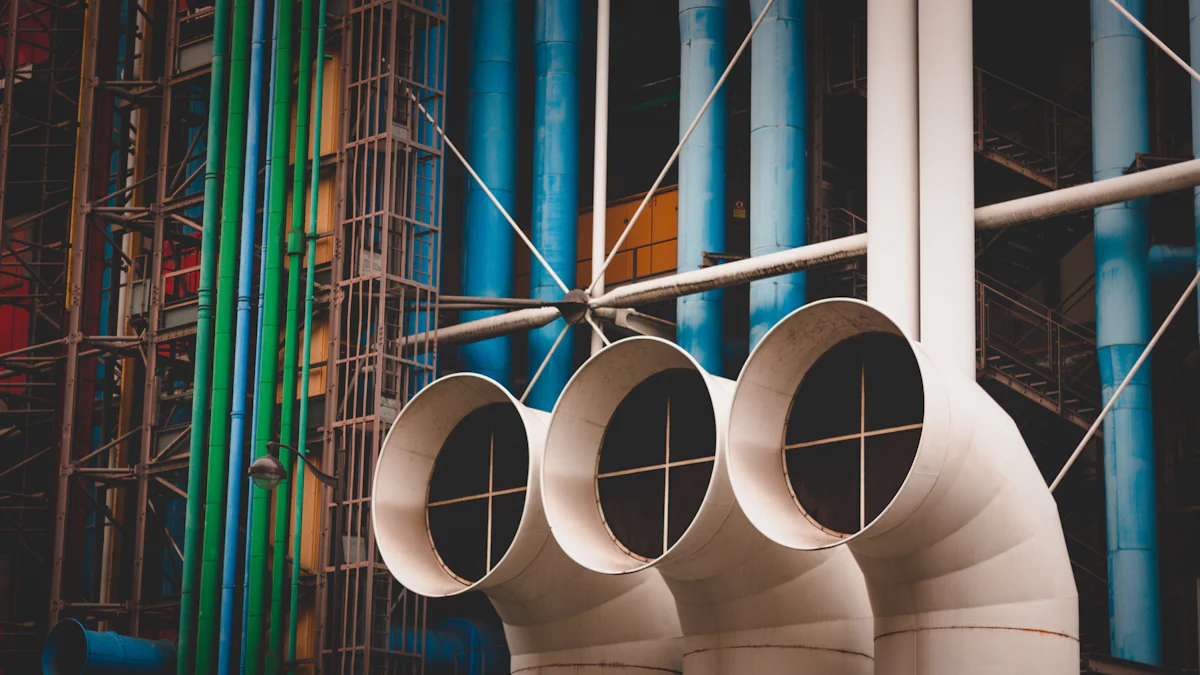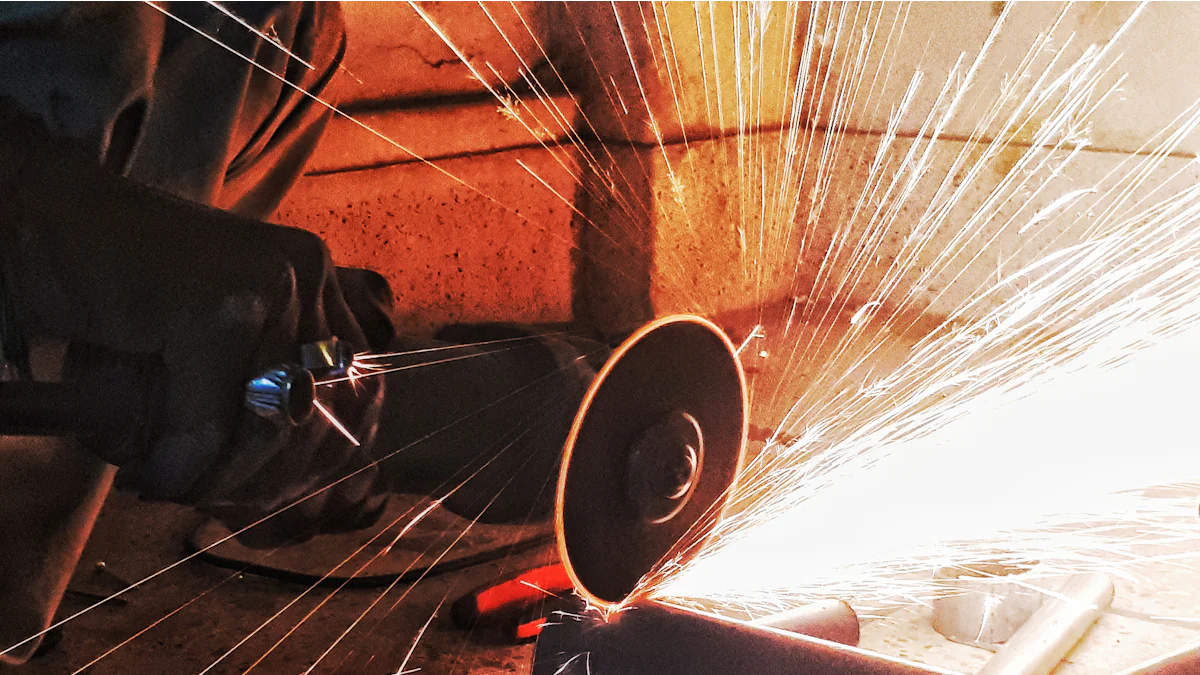
News

Induction heating revolutionizes the way you treat stainless steel pipes. This method uses electromagnetic fields to heat the metal quickly and efficiently. You can achieve precise control over the temperature, ensuring optimal results. Induction heating improves ductility and relieves internal stresses, making it essential for high-quality pipe production. The Induction Heating Machine For Stainless Steel Pipe and Induction Post Weld Heat Treatment Machine are vital tools in this process. These machines, part of the Pipe Heat Treatment Equipment, ensure consistent and reliable annealing, enhancing the overall quality of your products.
Key Takeaways
Induction heating offers precise temperature control, allowing for uniform heating of stainless steel pipes, which enhances their mechanical properties.
This method significantly reduces processing time compared to traditional heating methods, boosting productivity in manufacturing.
Induction heating is energy-efficient, leading to lower operational costs and a reduced environmental impact, making it a sustainable choice for industries.
The process improves the surface finish of pipes, ensuring high-quality aesthetics and corrosion resistance for demanding applications.
Investing in induction heating equipment can yield a favorable return on investment through increased efficiency and product quality over time.
Proper training and safety protocols are essential for operating induction heating systems, ensuring safe and effective use in production environments.
Embracing technological advancements in induction heating can enhance production capabilities and keep businesses competitive in the metal processing industry.
Understanding Induction Heating

Induction heating stands as a transformative technology in the realm of metal processing. By utilizing electromagnetic fields, you can heat metals like stainless steel with remarkable speed and precision. This method not only enhances efficiency but also ensures that the material properties remain intact.
Basic Principles of Induction Heating
At its core, induction heating relies on electromagnetic induction to generate heat within a material. When you pass an alternating current through a coil, it creates a magnetic field. This field induces eddy currents within the metal, causing it to heat up due to electrical resistance. The beauty of this process lies in its ability to heat the metal directly and uniformly, minimizing energy loss and maximizing efficiency.
Localized Heating: You can target specific areas of the metal, reducing the risk of overheating adjacent parts.
Precise Temperature Control: Adjusting the frequency and power of the current allows you to control the temperature with high accuracy.
Time Efficiency: The rapid heating process significantly cuts down on processing time compared to traditional methods.
Application to Stainless Steel Pipes
When it comes to stainless steel pipes, induction heating offers unparalleled advantages. The process is particularly beneficial for annealing, where you aim to relieve internal stresses and improve ductility. By applying induction heating, you ensure that the entire pipe reaches the desired temperature uniformly, which is crucial for achieving consistent results.
Enhanced Mechanical Properties: Induction heating improves the ductility and toughness of stainless steel pipes, making them more resilient in demanding applications.
Surface Finish Improvement: The process also enhances the surface finish, which is vital for applications where aesthetics and corrosion resistance are important.
Space Efficiency: Induction heating systems require less space compared to traditional furnaces, making them ideal for production lines with limited space.
Scientific Research Findings: Studies have shown that induction heating can significantly reduce wear on equipment by pre-heating steel sheets before cold rolling. This not only extends the life of the equipment but also improves the overall efficiency of the production process.
By embracing induction heating, you position yourself at the forefront of technological advancement in metal processing. The benefits are clear: increased efficiency, improved product quality, and reduced operational costs. Make the switch to induction heating and experience the difference it can make in your production line.
Benefits of Induction Heating for Annealing
Induction heating offers numerous advantages when it comes to the annealing of stainless steel pipes. By choosing this method, you ensure that your production process is both efficient and environmentally friendly. Let's explore the key benefits that make induction heating a superior choice for annealing.
Efficiency and Precision
Induction heating stands out for its remarkable efficiency and precision. Unlike traditional methods, induction heating generates heat directly within the steel pipe. This direct heating approach minimizes energy loss and ensures that the entire pipe reaches the desired temperature uniformly. You gain precise control over the heating parameters, including temperature and holding time, which results in consistent and uniform properties of the annealed material.
Fast and Uniform Heating: Induction heating rapidly heats the steel, reducing processing time and enhancing productivity. The uniform heating ensures that the material properties remain consistent throughout the pipe.
Non-Contact Heating: The non-contact nature of induction heating eliminates the risk of contamination, preserving the quality of the steel.
Reliable Control: You can precisely control the temperature and time of heating and cooling, ensuring that the steel pipe achieves the desired mechanical properties.
Energy Savings and Environmental Impact
Induction heating is not only efficient but also environmentally friendly. By using electromagnetic fields to generate heat, you significantly reduce energy consumption compared to traditional annealing methods. This reduction in energy usage translates to lower operational costs and a smaller carbon footprint.
Energy Efficiency: Induction heating systems consume less energy, making them a cost-effective choice for large-scale production.
Reduced Emissions: The process generates fewer emissions, contributing to a cleaner and more sustainable manufacturing environment.
Thermal Removal of Impurities: During bright annealing, induction heating can thermally remove impurities, enhancing the quality of the steel pipe.
By adopting induction heating for annealing, you not only improve the efficiency and quality of your production process but also contribute to a more sustainable future. The benefits are clear: precise control, energy savings, and a reduced environmental impact. Make the switch to induction heating and experience the transformative effects it can have on your steel pipe production.
The Process of Online Solid Annealing

Embarking on the journey of online solid annealing for stainless steel pipes involves a meticulous induction heating process. This method ensures that you achieve the desired mechanical properties and surface finish. Let's delve into the step-by-step process and the key parameters you need to control.
Step-by-Step Process Overview
Preparation: Begin by ensuring that the stainless steel pipe is clean and free from any contaminants. This step is crucial as impurities can affect the quality of the annealing process.
Induction Heating Setup: Position the steel pipe within the induction heating coil. The coil generates an electromagnetic field, which induces eddy currents within the pipe, causing it to heat up rapidly.
Temperature Control: Monitor the temperature closely. The induction heating process allows you to adjust the frequency and power of the current, ensuring precise control over the heating temperature. Typically, you aim for a temperature around 1060°C.
Holding Time: Maintain the desired temperature for a specific duration. This holding time is essential for relieving internal stresses and enhancing ductility. The duration may vary based on the pipe's thickness and material composition.
Cooling: After the heating phase, allow the steel pipe to cool down gradually. Controlled cooling is vital to prevent any thermal shock and to ensure uniform mechanical properties throughout the pipe.
Inspection: Conduct a thorough inspection of the annealed pipe. Check for any defects or inconsistencies in the surface finish and mechanical properties.
Key Parameters and Control Measures
To achieve optimal results in the induction heating process, you must focus on several key parameters:
Frequency and Power: Adjust these settings to control the depth and intensity of the heating. Higher frequencies are suitable for surface heating, while lower frequencies penetrate deeper into the material.
Heating Time: Determine the appropriate heating time based on the pipe's dimensions and desired properties. Shorter times may suffice for thinner pipes, while thicker pipes require longer durations.
Cooling Rate: Control the cooling rate to prevent any adverse effects on the steel's microstructure. A gradual cooling process helps maintain the desired mechanical properties.
Monitoring Systems: Implement advanced monitoring systems to track the temperature and other critical parameters in real-time. These systems provide valuable data, allowing you to make necessary adjustments during the process.
By mastering these parameters, you ensure that the induction heating process for online solid annealing is both efficient and effective. This approach not only enhances the quality of your stainless steel pipes but also optimizes your production line's performance. Embrace the power of induction heating and witness the transformation in your manufacturing capabilities.
Equipment and Technology
In the world of stainless steel pipe processing, having the right equipment is crucial. You need reliable and efficient tools to ensure that your induction heating process runs smoothly. Let's explore some of the cutting-edge technology that makes this possible.
Canroon's Induction Heating Machine
Canroon's Induction Heating Machine stands out as a leader in the field of induction heat treatment equipment. Designed specifically for stainless steel pipes, this machine offers unparalleled precision and efficiency. You can rely on it for post-weld heat treatment, dehydrogenation heat treatment, and intermediate stress relief. These processes are essential for industries like oil and gas piping, offshore platform construction, and power plant maintenance.
Versatility: Canroon's machine adapts to various applications, making it a versatile choice for different industrial needs.
Efficiency: The machine's design ensures rapid and uniform heating, reducing processing time and energy consumption.
Reliability: With Canroon's equipment, you achieve consistent results, enhancing the quality and durability of your steel pipes.
By choosing Canroon's induction heating machine, you invest in technology that boosts your production capabilities and ensures high-quality outcomes.
Technological Advancements Enhancing the Process
The field of induction heating has seen significant technological advancements, transforming how you approach steel pipe processing. These innovations enhance the efficiency and effectiveness of the heating process, providing you with superior results.
Advanced Control Systems: Modern induction equipment features sophisticated control systems that allow you to monitor and adjust heating parameters in real-time. This precision ensures optimal temperature control and uniform heating throughout the tube.
Energy Efficiency: New technologies focus on reducing energy consumption, making the induction heating process more sustainable and cost-effective. You benefit from lower operational costs and a reduced environmental impact.
Compact Design: Today's induction heating equipment is designed to be space-efficient, fitting seamlessly into production lines with limited space. This compactness does not compromise performance, allowing you to maximize your production capacity.
These technological advancements empower you to achieve higher productivity and better quality in your steel pipe processing. By embracing these innovations, you stay ahead in the competitive landscape of metal processing.
Challenges and Considerations
When you consider adopting induction heating for stainless steel pipe annealing, you must weigh several challenges and considerations. These factors can impact your decision-making process and influence the overall success of your production line.
Equipment Costs and Investment
Investing in induction heating equipment requires a significant financial commitment. The initial cost of purchasing high-quality induction machines can be substantial. However, this investment often pays off in the long run through increased efficiency and reduced operational costs. You should evaluate the potential return on investment by considering the long-term benefits of improved product quality and energy savings.
Initial Investment: High-quality induction heating machines come with a hefty price tag. You need to budget for this upfront cost.
Maintenance Costs: Regular maintenance ensures the longevity and reliability of your equipment. Factor in these ongoing expenses when planning your budget.
Return on Investment: Despite the initial costs, induction heating can lead to significant savings over time. Reduced energy consumption and enhanced productivity contribute to a favorable ROI.
Expert Testimony: According to DW Induction Heater, "Induction annealing enables precise and reliable control of metal material properties." This precision can justify the investment by ensuring consistent product quality.
Technical Expertise and Training Requirements
Operating induction heating equipment demands a certain level of technical expertise. You must ensure that your team possesses the necessary skills to manage and maintain the equipment effectively. Investing in training programs can enhance your team's capabilities and maximize the benefits of induction heating.
Skill Development: Your team needs to understand the intricacies of the induction process. Training programs can equip them with the knowledge required to operate the equipment efficiently.
Safety Protocols: Induction heating involves high temperatures and electromagnetic fields. Implementing strict safety protocols protects your team and ensures a safe working environment.
Continuous Learning: As technology evolves, staying updated with the latest advancements in induction heating is crucial. Encourage continuous learning to keep your team at the forefront of industry developments.
By addressing these challenges and considerations, you can make informed decisions about integrating induction heating into your production process. The benefits of improved efficiency, product quality, and sustainability often outweigh the initial hurdles. Embrace the potential of induction heating and position your business for success in the competitive world of stainless steel pipe manufacturing.
In conclusion, induction heating stands as a transformative method for stainless steel pipe annealing. You benefit from precise temperature control, rapid heating rates, and significant energy efficiency. This technology enhances product quality and process efficiency, making it an essential tool in modern industrial applications. By adopting induction heating, you not only improve the mechanical properties of your pipes but also contribute to a more sustainable production process. Embrace this innovative approach to stay ahead in the competitive landscape of metal processing.
FAQ
What is induction heating?
Induction heating uses electromagnetic fields to heat metals. This method heats the metal directly and efficiently. You can control the temperature precisely, making it ideal for processes like annealing.
Why choose induction heating for stainless steel pipes?
Induction heating offers precise temperature control and rapid heating. It improves ductility and relieves internal stresses in stainless steel pipes. You achieve consistent quality and save energy compared to traditional methods.
How does induction heating improve energy efficiency?
Induction heating generates heat directly within the metal. This direct approach minimizes energy loss. You use less energy, which reduces operational costs and environmental impact.
What equipment do I need for induction heating?
You need an induction heating machine designed for your specific application. Canroon's Induction Heating Machine is a reliable choice. It offers precision and efficiency for stainless steel pipe processing.
Is induction heating safe to use?
Yes, induction heating is safe when you follow proper protocols. You should implement safety measures to protect against high temperatures and electromagnetic fields. Training your team ensures safe operation.
How does induction heating affect the surface finish of pipes?
Induction heating enhances the surface finish of stainless steel pipes. It provides uniform heating, which improves aesthetics and corrosion resistance. You achieve a high-quality finish suitable for demanding applications.
What are the initial costs of adopting induction heating?
The initial investment in induction heating equipment can be significant. However, you benefit from increased efficiency and reduced energy costs over time. Consider the long-term return on investment.
Do I need special training to operate induction heating equipment?
Yes, operating induction heating equipment requires technical expertise. You should invest in training programs for your team. This ensures efficient operation and maximizes the benefits of the technology.
Can induction heating be integrated into existing production lines?
Yes, induction heating systems are compact and adaptable. You can integrate them into existing production lines with limited space. This flexibility allows you to enhance your manufacturing capabilities without major disruptions.
What industries benefit most from induction heating?
Industries like oil and gas, automotive, and aerospace benefit from induction heating. You achieve high-quality results in applications requiring precise temperature control and efficient processing.
Previous:
Next:
Please give us a message